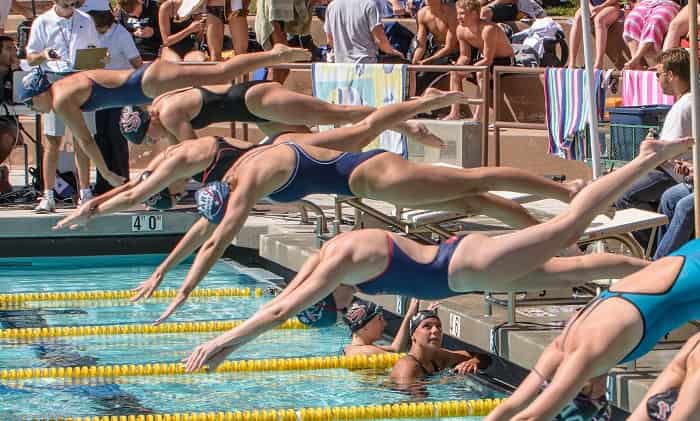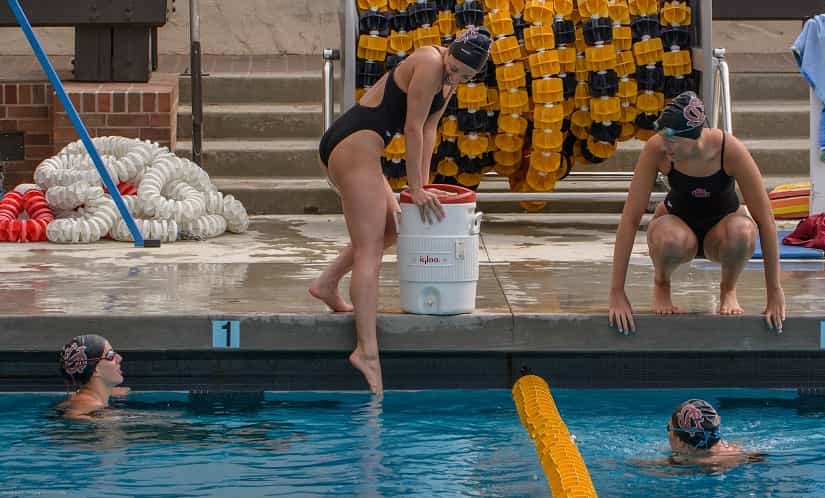It’s the day of the big race and you are ready to throw down on your PB’s. Here is a proven way to supercharge your warm-up so that your hard work shows up at race time.
It’s a super common sight at local swim meets: swimmers bundled up in a toque, swimming parka, and gloves in an effort to stay somewhat warm while sitting on a cold set of metal bleachers.
As a young age grouper we’d all pack our thick swim parkas anytime we went away for a swim meet, regardless of the time of year. I didn’t really understand the point of it at the time—the senior swimmers did it, so that was enough reasoning for me—but as I’ve gotten older and better, I have come to appreciate warming up, and it makes sense.
In order to swim fast, when it matters most, your core temperature needs to be up, and your muscles need to be primed.
But because of the lengthy gaps that often happen between warm-up and your first race, and the extended periods of sitting on our butts, the temperature of our core quickly plummets, rendering that extensive and well-planned swim meet warm-up a little useless.
Here is what you can do to make the most of your warm-up and be fully ready to lay a chlorinated butt-kicking on your best times.

How to Make Your Warm-Up Last All Day Long
It’s a common problem–you’ve done your warm-up, but now there is a long gap before your race. Compounding the problem there isn’t a secondary pool for you to jump into to re-warm.
So instead you end up sitting on a cold set of bleachers, growing cool and chilly. By the time you actually race again that warm-up has long since passed its expiry date, leaving you swimming below your potential.
Fortunately, there are some things you can do in order to stretch out the effectiveness and potency of your warm-up.
Researchers in Australia took a group of 16 junior national-level swimmers and had them complete a standardized, ascending effort warm-up designed to prime them for a time-trial swim later on:
- 400m Freestyle loose
- 3 x 100m IM (Kick, Drill, Swim)
- 3 x 100m Freestyle (80, 90, 95%)
- 4 x 50m Freestyle (15m fast, 35m cruise)
- 4 x 25m from a dive fast.
Once the warm-up was completed the swimmers got out of the water and took a 30-minute break before performing the 100m. All sixteen swimmers performed the time trial with all four sets of conditions, separated by two days during an aerobic phase of training:
- Control: The swimmers put on track pants and a t-shirt and sat around between the warm-up and time-trial. The control was designed to mimic typical conditions at a swim meet.
- Passive: These swimmers wore a tracksuit jacket that had “heating elements” added that were designed to keep the chest, shoulders and lower back warm. Kind of like a heat pack, but stylish and wearable.
- Dryland: These swimmers wore the same track pants and t-shirt, but performed a 5-minute dryland circuit that was designed to reflect movements swimmers would be performing in the water. The exercises included medicine ball throw downs, box jumps, and streamlined dolphin kicking on their back with a BodyBlade.
- Combo: As the name suggests, the swimmers wore both the heated jacket and also performed the dryland routine. The jacket was worn during the dryland, right up until the moment they got up on the blocks.
So how did the swimmers end up doing?
The combo swims performed best, performing almost a full second faster on average compared to the control. Here is what the four different groups averaged out for their 100m time-trials:
- Combo: :59.90
- Dryland: 1:00.26
- Passive: 1:00.37
- Control: 1:00.70
Start times to 15m were also considerably faster with the combo swimmers (6.86 seconds vs. 7.23 for the control).
The reasons the researchers found for improvements in performance came down to core temperature maintenance and pre-race muscle activation. The swimmers whose core temperature decreased the least saw more significant increases in performance.
Performing some snappy dryland exercises shortly before your race makes intuitive sense—you are priming or re-priming your muscles for some violent swimming.
The Takeaway
Swim meets can be a long-winded event; you don’t need me to tell you this. From warm-up to race time there is often long gaps where you find your butt falling asleep from being parked on ricketty old metal bleachers.
Staying warm, and keeping your core temperature up, can be done by properly timing your warm-up, staying nice and toasty, and also priming your muscle pre-race with a quick dryland circuit.
This little combination of activities between your initial warm-up and the time you get up on the blocks will help insure that you’ll be the swimmer behind the blocks whispering…
Hey…personal best time…yeah, you… you’re gonna get it.”
More Stuff Like This:
The Swimming Warm-Down: Why It Matters & How Much You Should Be Doing. Your coach has told you time and time again to warm down properly. Whether it’s after a race or after a big practice here is why you should invest some time gearing down after a tough effort.
How to Swim Faster Freestyle. Ever wondered what kind of freestyle technique is most effective? Here is what you need to know about leveling up your freestyle.
Swimming Tips: The 7 Fundamentals of Faster Swimming. Whatever your specialty, the principles behind fast swimming are the same. Here is how to make the most of each of them so that you can be the best swimmer you can be.














